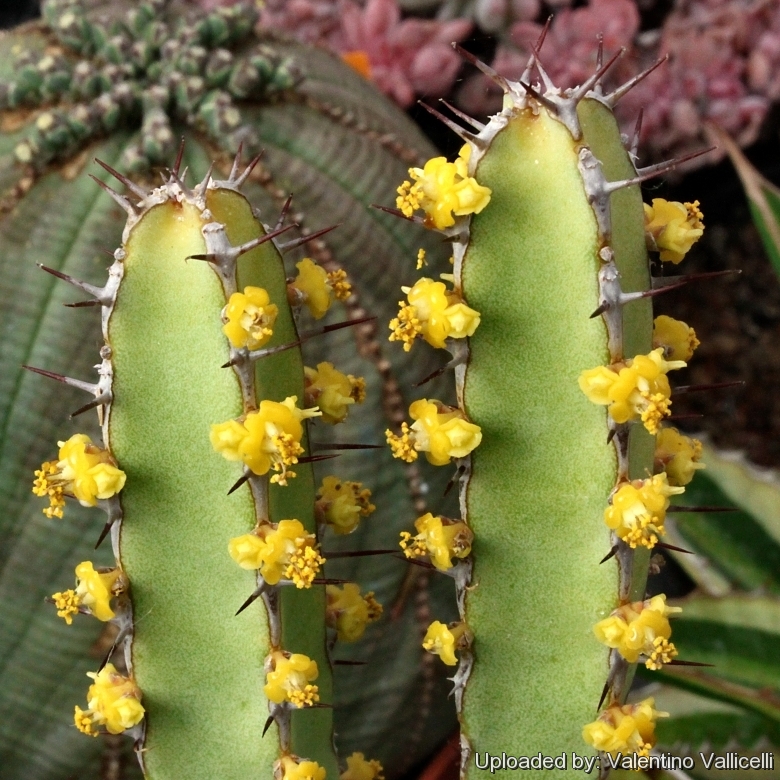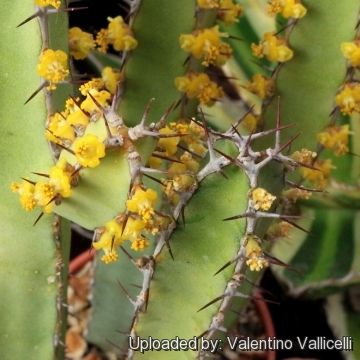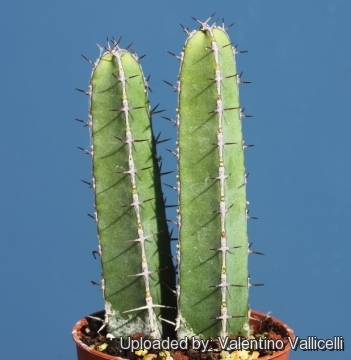




Your support is critical to our success.
Fl. Pl. South Africa 1933, xiii. t. 486.
Family: EUPHORBIACEAE

Origin and Habitat: Endemic to the Steenkampsberg, the Blyde River Canyon and the adjacent Olifants River Gorge. South Africa (Mpumalanga: Bushveld area). Type locality: Lydenburg, town in Mpumalanga
Altitude: 650 - 960 metres above sea level.
Habitat: It grows in rocky outcrops and valleys along side with Aloe wickensiiSN|25075]]SN|25075]].
Synonyms:
- Euphorbia lydenburgensis Schweick. & Letty
AFRIKAANS (Afrikaans): Lydenburg-naboom
Description: Euphorbia lydenburgensis is a much branched, spiny, cactus-like, succulent shrub with characteristic thin branchlets. Lovely colour combination when yellow flowers appear in spring. Its nearest relative is Euphorbia griseola.
Habit: Shrub without a distinct main stem, or with a reduced main stem, branching from the base and rebranching above near the apex, with a flat crown, up to 1,5 (usually about 60 cm.) high.
Stem: Branchlet ascending or erect, slightly constricted at irregular intervals, 4 (or rarely 5)-angled, 10-15 mm wide, with the sides slightly concave, glabrous, angles with shallow situate teeth approx. 1 cm apart; uniformly greenish-yellow.
Spine shields: Horny and forming a continuous ridge.
Spines: Slender, paired, 6-7 mm long. Stipular spines less than 1 mm long.
Flowers: Just above the spines on the ridges of the terminal segment; Cyathia single, 3 mm in diameter; bisexual; yellow. Nectar glands oblong, yellow, just touching.
Blooming season: Early spring (In habitat in September).
Fruit: Sessile 3-lobed capsule, 3-6 mm in diameter, red when mature, lobes obtuse, splitting maturing in late spring (In habitat October-November).
Seeds: Ovoid 2 mm long, 1,75 mm broad, somewhat tuberculate.
Bibliography: Major references and further lectures
1) Ernst Schmidt, Mervyn Lötter, Warren McCleland “Trees and Shrubs of Mpumalanga and Kruger National Park” Jacana Media, 01/gen/2002
2) Alain Campbell White, Robert Allen Dyer, Boyd L. Sloane “The succelent Euphorbisae (southern Africa)” Abbey garden press, 1941
3) Urs Eggli “Illustrated Handbook of Succulent Plants: Dicotyledons” Springer, 2002
4) Hermann Jacobsen “A handbook of succulent plalnts: Abromeitiella to Euphorbia” Blandford Press, 1960

Euphorbia lydenburgensis Photo by: Valentino Vallicelli

Euphorbia lydenburgensis Photo by: Valentino Vallicelli
Cultivation and Propagation: Euphorbia lydenburgensisSN|12587]]SN|12587]] is another easy plant to grow. It makes great potted specimens.
Growth rate: It grows well, though slowly, but it possible to increase the speed of growth to some extent by providing adequate amount of water, warmth, and a liquid fertilizer diluted half strength during the active growing season, but it’s susceptible to rotting if too wet. Most plants will offset readily, and large bushes can be produced in a few years.
Soil:Likes porous sub-acidic substrata (pH 6) with adequate drainage. Outdoors it does well on poor, rocky soils.
Exposure: Need bright light (also blasting sun in summer) to partial shade for best appearance. It responds well to warmth, with its active growth period in the late spring and summer months. If grown indoor provide 4 to 6 hours, or more, direct morning or afternoon sun.
Watering: Water thoroughly when soil is dry to the touch during active growing season (more than once a week during hot weather) In the winter months, waterigs should be suspended or restricted to once over the winter. The most common failure in growing this plant is over watering, especially during the winter months.
Hardiness: Very tender, protect from frost. During winter month, put them in a cool luminous place and encourage them to enter winter dormancy by withholding water and fertiliser over the winter as they will etiolate, or become thin, due to lower levels of light.
Maintenance: Repot every two years. Needs lots and lots of space to grow, use large shallow container filled with very porous compost. It like pots with generous drain holes.
Reproduction: It is propagated by cuttings. The seeds may be germinated and grown in containers. Their main requirements consist of high humidity levels, free-draining soil mix, and enough water, light, and nutrition. It is recommend taking Euphorbia cuttings in Spring/Summer when the plant is growing so that they have a better chance of success. They key is heat & good air circulation. These cuttings should be dipped in Hormone powder (but it is not needed) and left for a period of 3-4 weeks to callous. Then pot the cutting and don't water ( or kept slightly moist) until rooted. These will root just fine, if you can put the pot outside in the summer, or put pot on a heating pad.
Warning: As with all other Euphorbias when a plant get damaged it exudes a thick white milky sap known as latex. This latex is poisonous and particularly dangerous for the eyes, skin and mucous membranes. So pay extreme attention not to get any in your eyes or mouth. Cultivated plants must be handled carefully.
| Your Actions | |
|---|---|
| Back to Euphorbia index | |
| Back to Euphorbiaceae index | |
 |
Back to Succulents Encyclopedia index |
Privacy stantement - Terms and conditions - How to cite - About us - Feedback - Donate



